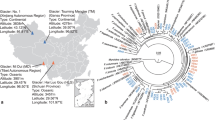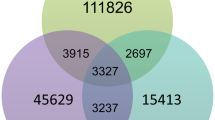Abstract
IN a recent communication1, Goodwin and Jamikorn state that light is necessary for the synthesis of astaxanthin, the carotenoid responsible for the red colour in the alga Haematococcus pluvialis. It is not clear whether this conclusion is reached as a result of their own experience or whether they are referring to earlier information2. In my opinion the conclusion is erroneous, for the following simple experiment convincingly demonstrates that dark synthesis is possible. The medium consists of 50 mgm./l. soil extract (1 per cent v/v of an extract yielding 5 gm. dry-weight of humic substance per litre on acidification), containing an amount of metabolizable nitrogen equivalent to 5 mgm./l. potassium nitrate, and is enriched with 500 mgm./l. anhydrous sodium acetate. A single green motile cell placed in 6 ml. of this medium multiplied, in complete darkness at 13–18° C. with a relative growth-rate (log2 increase per day) of 0.55–0.6, to a maximum of 214.3 cells per ml. in thirty days, further increase being prevented by nitrogen depletion. At this juncture the cells were still motile and green. Astaxanthin first became visible in the cells on microscopic examination fourteen days later, that is, on the forty-fourth day of the experiment. Encystment was complete after a further ten days, by which time enough astaxanthin had accumulated for the cells to appear bright orange to the naked eye.
Similar content being viewed by others
Article PDF
References
Goodwin, T. W., and Jamikorn, M., Biochem. J., 57 (3), 376 (1954).
Lwoff, M., and Lwoff, A., C.R. Soc. Biol. Paris, 105, 454 (1930).
Author information
Authors and Affiliations
Rights and permissions
About this article
Cite this article
DROOP, M. Carotenogenesis in Haematococcus pluvialis . Nature 175, 42 (1955). https://doi.org/10.1038/175042a0
Issue Date:
DOI: https://doi.org/10.1038/175042a0
This article is cited by
-
A new flagellated dispersion stage in Paraphysoderma sedebokerense, a pathogen of Haematococcus pluvialis
Journal of Applied Phycology (2016)
-
Accurate quantification of astaxanthin from Haematococcus crude extract spectrophotometrically
Chinese Journal of Oceanology and Limnology (2012)
-
Secondary ketocarotenoid astaxanthin biosynthesis in algae: a multifunctional response to stress
Photosynthesis Research (2010)
-
The present perspective of astaxanthin with reference to biosynthesis and pharmacological importance
World Journal of Microbiology and Biotechnology (2010)
-
Astaxanthin production by Phaffia rhodozyma and Haematococcus pluvialis: a comparative study
Applied Microbiology and Biotechnology (2007)
Comments
By submitting a comment you agree to abide by our Terms and Community Guidelines. If you find something abusive or that does not comply with our terms or guidelines please flag it as inappropriate.



